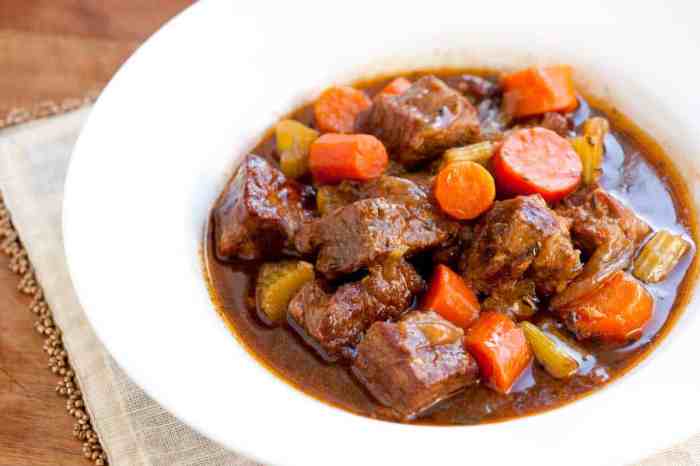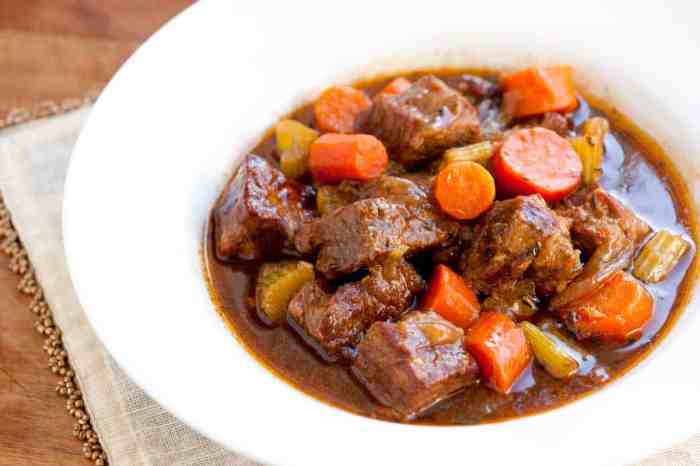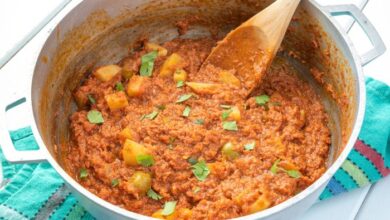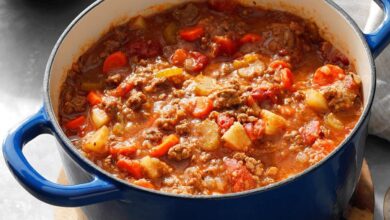
Beef and Guinness Stew: A Hearty Irish Classic
Beef and Guinness stew, a dish synonymous with Ireland’s culinary heritage, is more than just a comforting meal; it’s a story of history, tradition, and the magic of slow cooking. This rich, savory stew, with its deep, dark sauce and tender beef, has captivated taste buds for generations, its origins intertwined with the history of Irish cuisine and the cultural significance of Guinness itself.
From its humble beginnings to its global popularity, beef and Guinness stew has evolved over time, reflecting local culinary traditions and embracing variations that showcase the diverse flavors of the world. Whether you’re a seasoned cook or a culinary novice, the allure of this classic dish lies in its simplicity, its ability to transform everyday ingredients into a truly satisfying meal.
History and Origins
Beef and Guinness stew, a hearty and comforting dish, has a rich history intertwined with Irish culture and culinary traditions. While the exact origins are debated, the dish’s evolution reflects the influences of various historical events and culinary practices.
The combination of beef and stout, a dark beer, is deeply rooted in Irish cuisine. Guinness, a renowned Irish stout, has long been a staple in Irish kitchens, utilized not only as a beverage but also as an ingredient in various dishes.
The use of stout in cooking adds a unique depth of flavor and richness to the dish, complementing the savory notes of beef.
The Historical Use of Guinness in Irish Cooking
The use of Guinness in Irish cooking dates back centuries, with evidence suggesting its inclusion in recipes as early as the 18th century. Guinness, with its distinct bitter and roasted flavor, was traditionally used in stews, sauces, and even desserts.
The beer’s malty and slightly sweet notes blended harmoniously with the flavors of meat, vegetables, and spices, creating a unique and flavorful culinary experience.
The inclusion of Guinness in Irish cooking was not simply a matter of culinary experimentation. It was a practical choice driven by the availability of the readily accessible ingredient. The brewing of stout was a significant part of Irish culture, and Guinness, in particular, was widely consumed.
Its use in cooking ensured that this staple ingredient was incorporated into everyday meals, making it a key element of Irish culinary heritage.
The Evolution of Beef and Guinness Stew
The recipe for beef and Guinness stew has evolved over time, reflecting the changing culinary landscape and the influence of various cultural interactions. While the core ingredients of beef, Guinness, and vegetables remain constant, the specific ingredients and cooking methods have varied.
Beef and Guinness stew is a classic comfort food, warming you from the inside out. It’s hearty and satisfying, perfect for a chilly evening. While the stew simmers, why not whip up a no bake pumpkin cheesecake pie for dessert?
The creamy, spiced pumpkin filling is a perfect complement to the rich, savory stew, creating a delicious and balanced meal.
Early recipes for beef and Guinness stew often featured simpler ingredients, focusing on the basic combination of beef, stout, onions, and carrots. As culinary techniques and ingredients became more diverse, the recipe expanded to include a wider range of vegetables, herbs, and spices.
This evolution reflects the growing sophistication of Irish cuisine and the increasing influence of international culinary trends.
The development of beef and Guinness stew also reflects the changing social and economic conditions in Ireland. As the country transitioned from a largely agrarian society to a more urbanized one, the dish adapted to meet the needs of a growing population.
The use of readily available ingredients, such as beef and Guinness, ensured that the stew remained a practical and affordable meal option.
Ingredients and Variations
Beef and Guinness stew is a hearty and flavorful dish that has captivated taste buds for generations. The rich, savory broth, tender beef, and an array of vegetables come together in a symphony of flavors that is both comforting and satisfying.
The key to a truly exceptional stew lies in the careful selection and preparation of its ingredients.
Ingredients
A good beef and Guinness stew is built upon a foundation of essential ingredients, each playing a crucial role in creating its unique character.
Beef and Guinness stew is a classic comfort food, perfect for a chilly evening. It’s hearty, flavorful, and incredibly satisfying. To complete the meal, I love serving it with a big bowl of macaroni salad for a crowd , which adds a refreshing contrast to the rich stew.
The creamy salad, with its bright flavors, balances the savory depth of the stew, making for a truly delicious and well-rounded meal.
| Ingredient | Description | Role in the Stew | Variations |
|---|---|---|---|
| Beef | A key component of the stew, typically a tougher cut like chuck, brisket, or shank, which benefits from slow cooking to achieve tenderness. | Provides the hearty protein base and adds richness to the broth. | Other cuts of beef, such as short ribs, oxtail, or even ground beef, can be used. |
| Guinness Stout | A dark Irish stout beer with a distinctive roasted barley flavor and a slightly bitter finish. | Adds depth of flavor and a hint of bitterness, enhancing the richness of the stew. | Other dark beers, such as porter or stout, can be substituted. |
| Vegetables | A variety of vegetables, such as carrots, onions, potatoes, celery, and mushrooms, are commonly used. | Provide texture, sweetness, and additional flavor to the stew. | Different vegetables, such as parsnips, turnips, or leeks, can be added depending on preference. |
| Spices and Herbs | A blend of spices and herbs, including bay leaves, thyme, rosemary, and black pepper, enhance the flavor profile. | Add warmth, complexity, and aromatic depth to the stew. | Other spices, such as paprika, garlic powder, or chili powder, can be incorporated for a more pronounced flavor. |
| Flour or cornstarch | Used to thicken the stew and create a rich, velvety texture. | Creates a sauce that coats the beef and vegetables. | Other thickening agents, such as tomato paste or arrowroot powder, can be used. |
| Beef broth or stock | Provides the base for the stew and adds additional depth of flavor. | Enhances the overall taste and creates a flavorful broth. | Chicken broth or vegetable broth can be substituted for a lighter flavor. |
Variations
The beauty of beef and Guinness stew lies in its versatility, allowing for endless variations to suit individual tastes and preferences.The choice of beef cut can significantly impact the texture and flavor of the stew. For a more tender and melt-in-your-mouth experience, cuts like short ribs or oxtail are excellent choices.
Alternatively, using ground beef creates a heartier stew with a more rustic feel.The vegetable selection can be customized based on personal preference and seasonal availability. While classic combinations include carrots, onions, potatoes, celery, and mushrooms, other vegetables like parsnips, turnips, leeks, or even winter squash can be incorporated for added flavor and texture.Spices and herbs can be adjusted to create a unique flavor profile.
Adding paprika, garlic powder, or chili powder can bring a touch of heat and complexity to the stew. Experimenting with different combinations of spices and herbs can lead to unexpected and delicious results.Regional variations of beef and Guinness stew often reflect local culinary traditions and ingredients.
Beef and Guinness stew is a classic comfort food, but sometimes you crave something a bit more intense. That’s when I turn to the insane oven beef ribs recipe I found online. The rich, smoky flavor and tender meat are simply irresistible.
But after indulging in those ribs, I always find myself craving the hearty, soul-warming goodness of a good beef and Guinness stew.
For example, in Ireland, the stew may feature hearty root vegetables like turnips and parsnips, while in England, it might include a touch of Worcestershire sauce for an extra layer of umami.
Cooking Techniques and Methods
The magic of a good beef and Guinness stew lies not only in the ingredients but also in the skillful execution of cooking techniques. This involves a series of steps, each contributing to the rich flavor and tender texture of the final dish.
Cooking Techniques and Methods
This section delves into the specific techniques used to create a delectable beef and Guinness stew, outlining the steps involved and offering valuable tips for achieving the perfect outcome.
Step-by-Step Guide
| Step | Technique | Description | Tips |
|---|---|---|---|
| 1 | Browning the Beef | This step involves searing the beef in a hot pan to create a flavorful crust. It enhances the taste and adds depth to the stew. | Use a heavy-bottomed pan for even heat distribution. Brown the beef in batches to prevent overcrowding and ensure proper browning. |
| 2 | Sautéing Aromatics | After browning the beef, sauté aromatics like onions, garlic, and carrots in the same pan to infuse the stew with their flavor. | Sauté until the onions are translucent and the carrots are slightly softened. |
| 3 | Deglazing the Pan | Deglazing the pan with Guinness or another liquid releases flavorful caramelized bits stuck to the bottom. This adds another layer of complexity to the stew. | Use a wooden spoon to scrape the bottom of the pan and release the flavorful bits. |
| 4 | Simmering | Simmering the stew in a Dutch oven or slow cooker allows the flavors to meld and the beef to become tender. | Simmer on low heat for at least 2-3 hours, or longer for a more tender result. |
| 5 | Thickening the Sauce | To create a rich and velvety sauce, thicken the stew with cornstarch or flour slurry. | Whisk the slurry with a small amount of cold liquid before adding it to the stew. Simmer until the desired consistency is reached. |
Slow Cooking
Slow cooking is crucial for achieving the perfect beef and Guinness stew. The gentle heat allows the tough cuts of beef to break down and become tender, while also allowing the flavors to meld and deepen.
“Slow cooking is the art of allowing time and gentle heat to transform simple ingredients into a culinary masterpiece.”
Using a Dutch oven or slow cooker is ideal for slow cooking. These vessels retain heat effectively, ensuring even cooking and preventing the stew from drying out.
Flavor Profile and Sensory Experience: Beef And Guinness Stew

A good beef and Guinness stew is a symphony of flavors, textures, and aromas that tantalize the palate and leave a lasting impression. The rich, savory notes of the beef blend harmoniously with the bittersweet depth of the Guinness, creating a culinary masterpiece that is both comforting and complex.
Flavor Profile
The flavor profile of beef and Guinness stew is characterized by a beautiful interplay of savory, sweet, and bitter notes. The beef, simmered in the Guinness, develops a deep, savory richness that is enhanced by the addition of vegetables like carrots, onions, and potatoes.
The Guinness, with its signature bittersweet character, adds a layer of complexity to the stew, balancing the sweetness of the vegetables and the savory notes of the beef. The bitterness of the Guinness also helps to cut through the richness of the stew, creating a well-rounded flavor profile that is both satisfying and refreshing.
Aroma
The aroma of beef and Guinness stew is equally captivating. The rich, earthy scent of the beef blends with the malty, roasted notes of the Guinness, creating an inviting aroma that fills the kitchen with warmth and comfort. The addition of herbs and spices, such as thyme, bay leaf, and peppercorns, adds further layers of complexity to the aroma, creating a truly sensory experience.
Texture
The texture of beef and Guinness stew is another key element that contributes to its overall appeal. The beef, cooked slowly until tender, melts in your mouth, providing a satisfyingly soft texture. The vegetables, cooked until they are tender but still retain some bite, add a contrasting texture that complements the richness of the beef.
The sauce, thickened by the Guinness and the natural juices released from the beef and vegetables, coats the ingredients and provides a rich, velvety texture that is both comforting and luxurious.
Sensory Experience, Beef and guinness stew
Imagine yourself on a cold winter evening, huddled by the fireplace with a steaming bowl of beef and Guinness stew. As you take a spoonful, the rich, savory aroma fills your senses, inviting you to take a bite. The tender beef melts in your mouth, releasing a wave of flavor that is both comforting and satisfying.
The vegetables, cooked to perfection, add a touch of sweetness and a contrasting texture that keeps your taste buds engaged. The Guinness, with its bittersweet depth, adds a layer of complexity that elevates the dish to a new level of culinary artistry.
Each bite is a symphony of flavors and textures that leaves you feeling warm, satisfied, and utterly content.
Serving and Pairing
A hearty and flavorful beef and Guinness stew deserves a complementary accompaniment to elevate the dining experience. This section will explore ideal side dishes and wine pairings that enhance the flavors and textures of the stew, creating a harmonious and satisfying meal.
Side Dishes
Side dishes for beef and Guinness stew should complement the richness and savory notes of the stew while providing contrasting textures. Here are some classic and creative options:
- Mashed Potatoes:Creamy and comforting mashed potatoes provide a smooth and satisfying contrast to the stew’s hearty texture. The richness of the potatoes complements the savory flavors of the beef and Guinness.
- Bread:Crusty bread, such as sourdough or rustic rolls, is perfect for soaking up the flavorful gravy and providing a textural contrast. The bread’s starchy nature also balances the richness of the stew.
- Vegetables:Roasted root vegetables like carrots, parsnips, and potatoes add sweetness and earthy notes that complement the stew’s savory flavors. Steamed green beans or broccoli provide a lighter and refreshing counterpoint to the heavier elements of the dish.
Wine Pairings
The robust flavors of beef and Guinness stew call for wines that can stand up to the dish’s intensity and complexity. Here are some recommended pairings:
| Dish | Pairing | Description | Rationale |
|---|---|---|---|
| Beef and Guinness Stew | Cabernet Sauvignon | Full-bodied red wine with notes of black fruit, spice, and oak | The wine’s bold tannins and fruit flavors complement the stew’s richness and savory notes, creating a balanced and harmonious pairing. |
| Beef and Guinness Stew | Zinfandel | Spicy red wine with notes of blackberry, pepper, and earth | The wine’s peppery notes and fruit flavors enhance the stew’s savory and earthy elements, creating a complex and satisfying pairing. |
| Beef and Guinness Stew | Malbec | Full-bodied red wine with notes of plum, chocolate, and vanilla | The wine’s dark fruit flavors and smooth tannins complement the stew’s richness and savory notes, creating a balanced and elegant pairing. |
Cultural Significance and Modern Popularity
Beef and Guinness stew, a dish deeply rooted in Irish culinary traditions, has transcended its origins to become a beloved comfort food enjoyed worldwide. This humble yet hearty stew embodies a rich cultural history, reflecting the ingenuity and resourcefulness of the Irish people.
Cultural Significance in Ireland
The origins of beef and Guinness stew can be traced back to Ireland’s history, where the ingredients were readily available and affordable. Beef, a staple protein source, was often used in stews and other hearty dishes. Guinness, a dark stout beer brewed in Dublin, was a popular beverage among the Irish working class.
The combination of these two ingredients created a dish that was both nourishing and flavorful, a testament to the Irish people’s ability to create culinary delights from simple, everyday ingredients.
The dish became a symbol of Irish culture, representing the country’s history, resilience, and culinary traditions.
Modern Popularity Worldwide
The popularity of beef and Guinness stew has extended far beyond Ireland’s borders, captivating taste buds across the globe. Its hearty and flavorful nature has made it a popular comfort food, particularly during colder months. The dish’s versatility, allowing for variations based on regional preferences and culinary traditions, has further contributed to its widespread appeal.
- Global Influences:The dish has been adapted and incorporated into cuisines around the world, with variations often reflecting local ingredients and cooking techniques.
- Culinary Innovation:Chefs and home cooks have experimented with different ingredients and techniques, resulting in unique and flavorful interpretations of the classic recipe.
- Media Representation:The dish has been featured in numerous cookbooks, television shows, and movies, further solidifying its status as a globally recognized comfort food.






